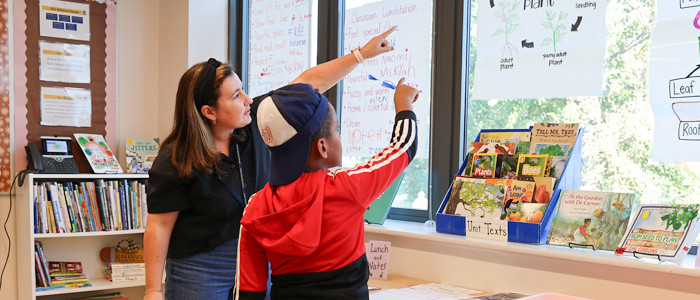What Students Are Learning
In the classroom, our educators are ready and waiting to give all students the knowledge and skills needed for success in college, careers, and life. We believe that a combination of excellent teaching, strong standards, and active student and family participation combine into a potent recipe for success. In this section, you’ll find information about standards and expectations, what students should know by grade and guidance that our teachers use to ensure consistency and equity across schools.
DCPS Common Core State Standards
Since we are committed to providing our students with a rigorous education, DC has joined 40 other states and five territories in adopting a new set of standards, the Common Core State Standards (CCSS). These standards lay out what students should know and be able to do in kindergarten through twelfth grade. The standards will help parents, teachers and community members understand what students should learn each year.
Also, because so many states have adopted the Common Core State Standards, we will be able to compare our students’ achievements to those of students around the country. Adopting the Common Core State Standards will have a major impact on the quality of education we provide our students.
Why is it important for DCPS to adopt the CCSS?
- Our students need to graduate from high school ready to be successful in college, careers and life. Yet, only 9 percent of 9th grade students in DC graduated from college within five years of finishing high school. Moreover, if you’re a DC student who just makes proficiency on the DC CAS, that level of proficiency translates to only a 16th percentile score on the SAT.
- Given our transient population, our current standards create challenges. When you inherit a 6th grade student from Maryland or Virginia, there are inevitably some standards that students already have mastered and others that will fall into a gap.
- In our current system of standards, we are comparing apples to oranges. Students in different states receive completely different educations, and this makes it difficult to discuss student performance across states.
For all these reasons, our students deserve better. By teaching according to the Common Core State Standards, we will ensure that our students get no less than our best.
What is the purpose for having the CCSS?
The main reason for the CCSS is to ensure that all students, no matter where they live, are prepared for success in postsecondary education and the workforce. Common standards will:
- Help ensure students are receiving a high-quality education consistently from school-to-school and state-to-state
- Provide a greater opportunity to share experiences and best practices within and across states.
- In other words, we finally will be able to compare apples to apples.
Who developed the CCSS?
The Common Core State Standards is a state-led effort to establish a shared set of English/Language Arts and math standards that states can voluntarily adopt.
Forty-eight states participated in the creation of the standards. To date, 40 states, five territories and the District of Columbia have adopted the standards.
Teachers, parents, administrators, educational experts, governors, state school officials, and national organizations were involved in the development of the CCSS.
Against which standards were the CCSS benchmarked?
While informed by strong existing state standards, the CCSS are internationally benchmarked so that all students are prepared to succeed in our global economy and society.
How will the CCSS be assessed?
The CCSS is assessed using the District of Columbia Comprehensive Assessments of Progress in Education (DC CAPE).
Scope and Sequence Documents
For each grade, the Scope and Sequence documents describe the "Units of Study" which establish consistency of instruction throughout the District - in different grade levels and subject areas - by providing clear guidance on what your children’s teachers should teach and when they should teach it.
For example, first-grade students throughout DCPS will learn about the solar system in August. This consistency will allow DCPS to provide targeted resources and support that all teachers can use and provide the opportunity for schools to share successful ideas with other schools across the district.
It also helps prevent interruptions or repetitions in transient students’ educations. Consider the common case of a student at School A on one side of town who then transfers to School B on the other side of town during the school year.
With common units in place, that student can now easily transition to her new school without missing any important information about the solar system. And since those lessons are taught across the district around the same time, the transfer student wouldn’t repeat the unit just because she changed schools.
To review the Scope and Sequence Documents, select your child's grade level.



